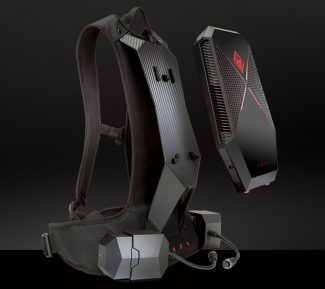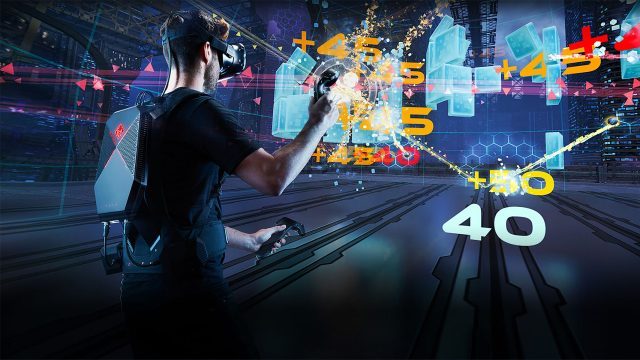One of the current barriers to immersion for high-end VR headsets is being tethered to a powerful PC. For now, there are two options if you want to eliminate that pesky cable: a special wireless adapter, or a backpack PC to let the rendering happen directly on your person. Here we take a look at a range of VR backpack computers and what they offer.
Intro
Wireless solutions such as TPCast are already available for the Vive and Rift, and the announcement of an official Vive Wireless Adaptor from HTC at CES 2018 indicates further momentum in this area, but the backpack PC still has valid use cases. Crowded networks at events can cause problems for some wireless systems; today’s wireless solutions sometimes mean additional latency, reduction in visual quality, and range restrictions compared to being directly attached to a back-mounted PC.
In an ideal world, VR headsets would be self-contained, comfortable, and unobtrusive. Higher-quality, integrated VR hardware will take important steps this year, with the likes of Oculus’ Santa Cruz project and various other standalone mobile VR headsets on the way, but the most visually-ambitious experiences will continue to demand powerful, ‘desktop-class’ PC hardware in the foreseeable future.
VR backpack PCs feature components typically found in high-end gaming laptops, repackaged into a more practical, wearable chassis. The systems are designed to be lightweight and durable, with specific considerations for VR: such as the positions of ports, optimised airflow away from the body, and hot-swappable batteries for extended or continuous use. Since NVIDIA introduced their near-desktop performance Pascal range of ‘mobile’ GPUs in late 2016, gaming laptops (and by extension, backpack PCs) have become more viable for VR, with even the ‘mobile’ GTX 1060 GPU meeting the ‘VR-ready’ spec. As a result, every PC listed below uses a Pascal-based GPU that meets the minimum bar collectively set by major VR companies like Valve, HTC, and Oculus.
Note: Each backpack PC listed here technically supports all current consumer PC VR headsets, but they were designed primarily for the HTC Vive, as its tracking beacons have no direct connection to the PC. Every backpack PC incorporates a power outlet for the Vive next to the other ports. The Windows “Mixed Reality” headsets are also suitable, as they require no external tracking, but the Oculus Rift is not (unless an alternate tracking system is employed) as its external tracking cameras must be connected to the PC.
HP Omen X Compact Desktop – $2,300


HP’s solution is perhaps the most elegant, with a dock that allows the unit to stand upright and operate as a standard desktop PC. The dock is included, but the backpack holster system is not, and is a $400 option. It is smartly-designed, with a brace that raises the bulk of the PC away from the user’s back to improve airflow, and its hot-swappable batteries are connected separately on the waist strap for better weight distribution. It also comes with an extra pair of batteries and a charging dock.
Unlike the designs from other manufacturers, the Omen X contains its own 55Whr battery so it can operate in desktop or backpack configuration without the two hot-swappable batteries being connected. All the other designs can be used in non-backpack configurations too, but their hot-swappable batteries are part of the main unit, and at least one needs to be connected if you’re not using mains power.
It is the only backpack PC with a mobile GTX 1080 (and overclocked for good measure), and therefore the highest performance option for VR gaming. Here’s a look at the specs on offer:
- CPU: 2.9GHz i7-7820HK
- GPU: GTX 1080 8GB GDDR5X
- RAM: 16GB DDR4-2400 (Max 32GB)
- Storage: 1TB M.2 SSD
- Weight: 8.27lb (3.75kg)
Latest pricing from Amazon:
Full overview and specifications can be found via the Omen X Compact Desktop webpage.
HP Z VR Backpack G1 Workstation – $3,300
Appearing as a less gamer-focused version of the Omen X Compact Desktop, the Z VR Backpack G1 Workstation is HP’s business-orientated VR backpack solution. It incorporates essentially the same design of dock and backpack, but its specifications are aimed at the commercial sector.
In particular, it uses the HQ variant of the i7-7820 CPU, which includes Intel vPro features, and is fitted with a Quadro P5200, currently the “most powerful mobile workstation GPU.” At 10lbs, the backpack is heavier than the Omen X version, most likely due to its reinforced, ‘military grade’ construction.
- CPU: 2.9GHz i7-7820HQ
- GPU: Quadro P5200 16GB GDDR5
- RAM: 16GB DDR4-2400 (Max 32GB)
- Storage: 256GB NVMe SSD (Upgradeable to 1TB)
- Weight: 10.25lb (4.6kg)
Latest pricing from Amazon:
Full overview and specifications can be found via the Z VR Backpack webpage.
MSI VR One – $1,900
At just 3.6kg, MSI says the VR One is the “thinnest and lightest” VR backpack PC, and manages to pack plenty of aggressive ‘body armour’ styling into its compact chassis. It is less of a dual-purpose design than the HP systems as its two hot-swappable batteries form part of the main body, but it could still be used as a desktop PC if needed. The ‘entry level’ version is the only model in this list using a GTX 1060, but a GTX 1070 version is also available for more graphical power.
The VR One originally launched with a Intel Skylake i7-6820HK CPU, but the latest units ship with the Kaby Lake i7-7820HK CPU, matching the HP Omen X. The Skylake version can still be found on sale, typically reduced by $100.
- CPU: 2.9GHz i7-7820HK
- GPU: GTX 1060 6GB GDDR5
- RAM: 16GB DDR4-2400 (Max 32GB)
- Storage: 256GB NVMe SSD
- Weight: 7.9lb (3.6kg)
Latest pricing from Amazon:
Full overview and specifications can be found via the VR One webpage.
Zotac VR Go – $1,900
Zotac’s VR Go is similar to MSI’s VR One in terms of its dual hot-swappable battery design, but with more conservative styling. It was also recently updated to the newer generation Kaby Lake processor, but it appears many retailers are still stocking the Skylake i7-6700T version at reduced prices. In either case, you’re getting a GTX 1070 GPU, and therefore the VR Go may represent the best ‘bang for buck’ in this expensive niche category. It is, however, notably heavier than the other systems here.
- CPU: 2.9GHz i7-7700T
- GPU: GTX 1070 8GB GDDR5
- RAM: 16GB DDR4-2133 (Max 32GB)
- Storage: 240GB M.2 SSD
- Weight: 10lb (4.5kg)
Latest pricing from Amazon:
Full overview and specifications can be found via the VR Go webpage.
XMG Walker – €2,500
Only available in Europe, the XMG Walker was the first VR backpack PC to hit the market, and remains an impressively sleek, lightweight system, with a similar chassis design to the MSI and Zotac. A variant of the XMG Walker launched in the Chinese market called Vest PC II (which appears to be even lighter than the MSI at 3kg) had plans to be sold in the US, but that doesn’t appear to have come to fruition.
For EU folk, the XMG Walker’s €2,500 price point is slightly more reasonable, although it has yet to receive a Kaby Lake CPU upgrade like the MSI or Zotac.
- CPU: 2.6GHz i7-6700HQ
- GPU: GTX 1070 8GB GDDR5
- RAM: 16GB DDR4-2400 (Max 32GB)
- Storage: 250GB M.2 SSD
- Weight: 8.4lb (3.8kg)
Full overview and specifications can be found via the XMG Walker webpage.

